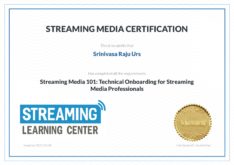HEVC is the next-gen compression technology lauded as the enabler for a host of new services and capabilities. I discuss the historical development of HEVC and its technical underpinnings in my article “What Is HEVC (H.265)?” This article focuses on how quickly the average streaming producer needs to start thinking about HEVC.
According to multiple studies, HEVC should deliver up to 50% better compression than H.264 in video on demand (VOD) applications, which means similar quality at half the bitrate. In live encoding, which obviously has to be performed in real time, the initial expectations are a 35% bandwidth reduction at similar quality levels. Alternatively, HEVC can also enable larger resolution movies, whether 2K or 4K.
Essentially, these are the two benefits of HEVC in the streaming space. The first relates to encoding existing SD and HD content with HEVC rather than H.264, enabling cost savings and/or the ability to stream higher quality video to lower bitrate connections. The second relates to opening up new markets for ultra-high-definition (UHD) videos.
How soon should you care? Well, streaming producers need three things to use an encoding technology; an encoder, a decoder and a price. While multiple vendors have already announced the availability of HEVC encoding, including an open-source encoder similar to x264, the playback and cost sides have yet to meaningfully coalesce.
How Much Will HEVC Cost? No One Knows.
Let’s look at the cost side first, since that’s a very significant driver for decode. To explain, as I’ve written before, HEVC is encumbered by multiple patents owned by multiple parties, and at this point, not all of the stakeholders have agreed to be represented as a single group.
In contrast, all companies who contributed intellectual property to the H.264 specification joined together into a group represented by MPEG-LA, and royalty charges were set long before the first streaming-related licensees started deploying the technology. As I wrote about here, many of the companies who contributed IP to the H.264 patent pool thought the ultimate H.264 licensing terms were far too lenient, and that they left serious money on the table. So not only are they reluctant to join the HEVC patent pool, they’ll likely propose much more aggressive licensing terms.
For example, one of the reasons H.264 was so successful was that there was no royalty on free internet video, including that distributed by companies like ESPN or CNN, who collectively make billions in advertising revenue on those H.264 streams. If you were an H.264 IP owner, you’d be pissed too. For this reason, you’d have to assume that if the video was monetized in any way, the HEVC group will want their share.
At this point, no one knows if a single patent group will be formed, or if there will be multiple groups, or even a rough idea as to the costs and associated policies. Until the cost structure is known, it’s hard to see any web properties start to use the technology. After all, while cutting your bandwidth costs in half sounds good, you can’t tell whether it’s actually going to save you money until the cost structure is known.
What About Playback?
Obviously, there’s no sense encoding with a new codec unless your viewers can play it back. At this point, the only free player that consumers can use to playback HEVC is the DivX player, which is great for DivX owners, but the numbers are far from ubiquitous. HEVC playback is not in Flash, it’s not on any mobile platform, it’s not in Windows or OSX.
As you may know, including H.264 playback in a product does give rise to royalty obligations, which Adobe (Flash), Apple (QuickTime, iOS), Google (Chrome, Android), Microsoft (IE, Windows, Windows Phone) and others historically and currently pay. This royalty obligation was one reason that Mozilla and Opera haven’t licensed H.264 for inclusion in Firefox and the Opera browser. However, H.264 has a per company, per annum cap of $5 million, which is pocket change to most companies that chose to license H.264 playback.
At this point, it’s expected that HEVC playback will also involve a similar royalty, but pricing and the cap (if any) is unknown. Small wonder there’s no rush to incorporate HEVC playback into browsers, plugins or desktop or mobile operating systems.
So, as we sit here today, only a very small fraction of potential viewers can play back HEVC. On the production side, you don’t know how much it will cost to distribute HEVC-encoded files, or even who to make the check out to. Overall, HEVC is the latest shiny new object that encoding vendors like to tout and the technology press likes to write about. But until the royalty policies are set, and playback close to ubiquitous, it’s hard to see how the HEVC is anywhere close to commercially relevant for a general-purpose website owner.
 Streaming Learning Center Where Streaming Professionals Learn to Excel
Streaming Learning Center Where Streaming Professionals Learn to Excel







